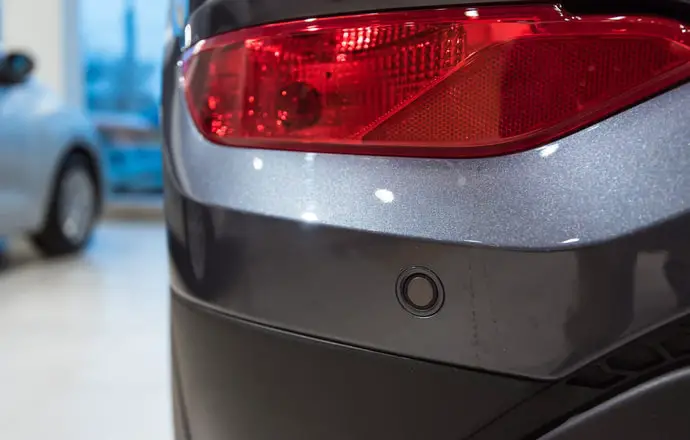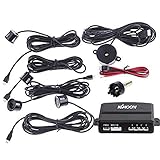Last Updated on September 28, 2022 by

Parking sensors are ideal for individuals who struggle to reverse or back their vehicle into parking spaces. These convenient and discrete sensors are drilled into the bumper of a vehicle and use a variety of systems to alert you, the driver, when you are getting too close to an object like a wall, pedestrian or other vehicles.
They’re a great little confidence booster if you’re not the most competent parker, giving you that extra helping hand and peace of mind when parking. Some sensors can be used in conjunction with a reversing camera, so you have a clear view aswell as a sound alert for gauging the correct distance and space.
So whether you’re a new driver, experienced, or even have a company fleet of vehicles you want to protect, check out our reviews of the 5 top reversing sensors, so you have your very own parking assistant with you at all times.
Best Parking Sensors in the UK Reviews
|
Image |
Sensor |
# of Sensors |
Price |
|---|---|---|---|
 |
Top Pick |
8 |
|
 |
4 or 8 |
||
 |
4 |
||
 |
4 |
||
 |
4 |
#1. Cocar Reverse Parking Radar System

The Cocar Reverse Parking Radar System is an 8-sensor system designed to help drivers detect the location of their car and surroundings. The sensors can be attached to the car or the walls of the garage. They are connected to an LED distance display and alarms which are triggered when you come to close to the sensors. The main control box is also placed in the vehicle.
These sensors are the same size as a drill head and are designed to be drilled directly into the bumper of a vehicle. Installation is simple and easy, and full detailed instructions are included upon purchase. However, if you cannot drill the holes yourself, it can be expensive to have the service done. The display is intuitive and will show you how far you are from an obstruction. The beeps become more frequent depending on closeness as well.
The Cocar system includes a 3-year limited warranty which covers manufacturer error and damage induced from regular wear and tear. There are also many colours to choose from to properly match your car, so you don’t have to worry about the sensors standing out while in use. Users should note that excessively rainy conditions will affect how well the sensors operate.
Pros
- Includes 8 sensors
- Easy to read display
- Warranty included
Cons
- Drilling is difficult
- Water affects accuracy
#2. TKOOFN Car Reverse Radar System

The TKOOFN system is available as a set of 4 or 8 sensors which are connected to an LED display and alarms. These sensors are small but powerful, capable of identifying even smaller obstructions like children or cats behind the car. The display is easy to read and install in any vehicle type, and instructions are included for the entire installation process. The control box is quite small and discrete and is simple to place inside the vehicle.
These sensors need to be drilled into the vehicle and are only available in black, silver, red, and white. However, the full system has a double CPU and chipset to improve the detection area and enhance coverage. The total detecting distance is 0.3-2.5 meters. The rated voltage is DC12V.
Plus, this system will not freeze and is also water-resistant. It will not be affected by rain, so you can rely on having a reliable sensor even during storms.
Pros
- Large detecting range
- Water-resistant
- Anti-freeze design
- Small and discrete
Cons
- The buzzer is high-pitched
- Long-range means sensors can activate at odd times
#3. Dolphin Automotive DPS400 Reverse Parking Sensors

One of the greatest features of these Dolphin Automotive parking sensors is their customizable nature. You won’t be limited when trying to find sensors that match your car, as there are 33 separate colours for almost every paint type. The sensors need to be drilled into the bumper and can work for the front or rear, depending on your personal preferences. This is a 4-sensor system that comes with a hole cutter, instruction manual, and an adjustable ‘brainbox’ which informs you when you are close to obstructions.
This is one of the simplest systems available and also one of the easiest to install. A notable feature is the swap socket, which helps you thread the sensors and ensure the wiring is connected properly. The swap socket also makes it easy to disconnect the sensors if they suffer damage and require replacement.
The Dolphin Automotive system is designed to be water and frost-resistant so they can still function in harsh UK weather conditions. The sensors can detect obstructions up to 1.5 meters away and are designed to emit intermittent beeps, which grow faster the closer you are to an item. To get an LCD screen that displays distance, you have to pay extra.
Pros
- Water and frost-resistant
- Brainbox
- Multiple colours to choose from
- Easy installation
- Swap socket feature
Cons
- Not suitable for small cars
- LCD screen costs extra

This is a 4-sensor system which features some extra technology to get the best and most accurate results. The computer system includes double CPU and an advanced chipset, as well as an intelligent central alarm which does not need to be wired throughout the car. The sensors can detect obstructions up to 2.5 meters away and are capable of noticing smaller obstructions like pets and low walls.
The KKmoon system is simple to install and works with most vehicle types. The sensors have high sensitivity and release intermittent beeps depending on how close to an object you are. A saw head is included to facilitate installation, and so are written instructions. The sensors are made with anti-freeze technology to help them work even during harsh UK winters. Rain can somewhat affect the accuracy of the sensors, so be careful in storms.
Plus, the KKmoon sensors are some of the most affordable on the market, so they are good if you want to save money while improving safety.
Pros
- Affordable
- Easy to install
- Frost-resistant
- Identifies low obstructions
Cons
- Affected by storms
- Low volume
#5. CISBO Sensor Kit

The CISBO sensor kit is another affordable option which works well on small to mid-sized vehicles. There are 4 sensors in each kit as well as a compact main unit and a discrete buzzer. While the buzzer is not as loud as other options, it gets the job done. These sensors can find obstructions up to 1.5 meters away and works well for lower objects like small walls and animals.
Full instructions are included with this kit, as well as a hole saw so you can drill into your bumper. There is only one colour (black), but a 3-year warranty is included from the manufacturer. This covers basic damage and any errors made by the company. While the CISBO sensors are water-resistant, they are not frost-resistant.
If you like products made domestically, the entire kit is manufactured in England and Wales.
Pros
- Small and discrete
- Senses low obstructions
- Easy to install
- Warranty included
- Made domestically
Cons
- Not frost-resistant
- One colour available
Sensors for Parking Buying Considerations
There is some crucial information to consider when purchasing parking sensors. The most important feature is the type of sensor, as this can affect the range and how they need to be installed on your vehicle. At present, there are three separate styles available: radar, camera, and fixed. All of the options on this list are radar sensors because they are the most affordable and easiest to install.
Radar
Radar sensors utilize invisible waves which are projected by the sensors. The waves bounce off of obstructions and back to the sensors, transmitting information and generating a 3D image of the surrounding world. These are simple and effective, but can be affected by rain and snow.
Camera
Camera sensors utilize small digital cameras which identify the distance between your bumper and an obstruction. Cameras will sometimes display an image to you to let you know where you are, but some will also just transmit information to an LED display. These are not as easily affected by the weather.
Fixed
Finally, there are fixed sensors. Fixed sensors are not installed on your vehicle. Instead, you place them in your garage and regular parking space. They will then sound the alarm when you get to close.
Number of Sensors
Once you know the type of sensors you would like, you need to consider how many you need. Larger vehicles might need up to 8, while most four-door cars will be alright with 4. Almost all systems bought and sold are 4-sensor systems that require you to drill holes in your bumper. These sensors can be placed in the front or rear.
Weatherproofing
Finally, consider weatherproofing. This refers to how affected the sensors are by wind, rain, snow, and other forms of weather. To get the most accurate parking sensors, you want a system that is water and frost-resistant. Unfortunately, not all inexpensive systems will have this option.
Final Verdict
Some types of parking sensors can be a little tricky to install, but are a great little addition to your vehicle for helping you avoid collisions when parking. If anything, they give you an excellent little confidence booster and could even potentially save you money in the long term by helping you avoid a nasty bump that will run up your insurance renewals. We have listed our 5 best parking sensor models to purchase, keeping in mind affordability and ease of installation, but still ensuring that they have all of the necessities you need to help keep you and your vehicle safe when reversing.
